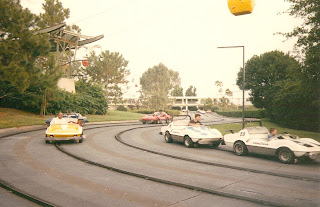As the saying goes, "A picture is worth a thousand words." Sometimes, an old photograph of a Disney Park can offer just as many windows to the past, as I recently discovered browsing the phenomenal collection over at Daveland.com. Take, for example, the photo above (image used with permission). Go ahead and click on it for a better view. What do you see?
The first thing that likely jumps out at you is the construction site. This spot on the edge of Fantasyland was once home to the Fantasyland Art Festival, where guests could have their portraits made or a caricature drawn. Today, it's where you'll find the Enchanted Grove snack stand, along with area restrooms and Fairytale Garden.
What intrigued me most about this image, though, was the Mad Tea Party. Now, I happen to know quite a bit about Walt Disney World, but I certainly don't know everything, so I especially love it when I come across some new nugget of information. Before seeing this picture, I had no idea the Mad Tea Party was built without a roof. Of course, the Disneyland version of the attraction is uncovered, but then again, it rains far less in Southern California than it does in Central Florida. This picture was taken in June 1972. Judging from other shots I've seen, it looks like it didn't take long for the park to commit to a canopy so they could keep the party going rain or shine.
Look around in the photo - really stare at it - and other details of the past will become apparent. Sticking with the Mad Tea Party, the color scheme of the turntable and teacups has changed over the years. You may also notice the top of the old operator booth, plus the fact that there's no teapot (or Dormouse) at the center or Alice in Wonderland topiaries and leaf sculptures in the planters. It's a bit hard to tell, since the image cuts off at the bottom, but the present day Mad Tea Party may even have more cups and saucers than this original, offering a higher capacity.
What else do you see? There's an original-design Fantasyland trash can and old school metal and blue rental stroller near the green teacup on the right. What about Cosmic Ray's Starlight Cafe? In 1972, this corner was the Tomorrowland Terrace (a name now used for the former Plaza Pavilion near Main Street). You can make out the red oval sign for the restaurant, jutting out from an old Tomorrowland pylon, and the original geodesic dome roof over the Tomorrowland Terrace stage. Sonny Eclipse holds forth nowadays, but back then this was the spot for live cover bands with names like "The Dallas Soundtrack" and "Tabasco."
Further afield, close observers might notice the original trees in the Central Plaza (since removed after they grew so large they obstructed the view), the lack of a rose garden pathway (the rose garden leads down to the old landing for the Plaza Swan Boats), and the absence of Disney's Grand Floridian Resort and Spa from the horizon (you can just make out the Grand Ceremonial House at Disney's Polynesian Resort).
This picture also includes a view of the giant waterfall pylons that once graced the entrance to Tomorrowland, but we'll talk more about those, well... tomorrow, when I'll have another great old photo to share. Until then, I'll leave you with one last observation: The vantage point from which today's photo was taken. You can't really see it (except for the blur at the lower right that is the out-of-focus edge of the cab), but our photographer was perched high above the Magic Kingdom on the Skyway to Tomorrowland.



















